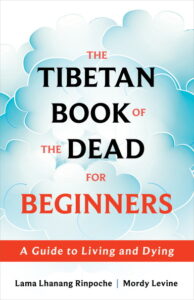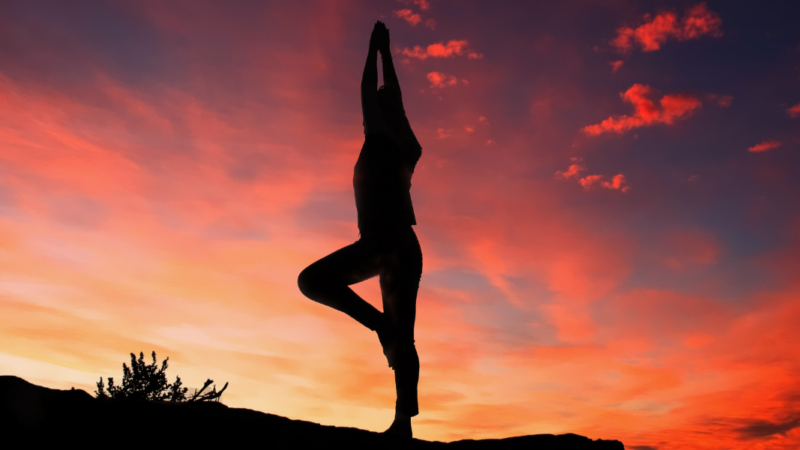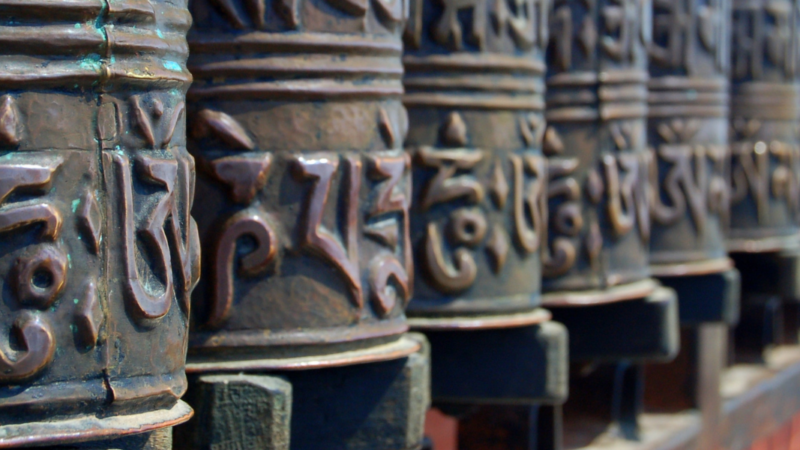How to Keep Your Mind from Wandering in a Yoga or Meditation Practice

PHASE 1
Mind wandering is associated with the DMN (default mode network)—areas of the brain that are active when the mind is in its default state of rest. In this phase, the mind seems cluttered with thoughts and feelings all scrambling to be at the center of attention. The meditator may remain distracted by what seems like an endless barrage for some period of time. The brain remains in this state especially when it is not engaged in a specific task.
PHASE 2
Becoming aware of mind wandering occurs when we mobilize a conscious mind-body practice. This phase involves purposefully placing our attention in order to steer our practice, and this effort reveals itself as activation in the insula. As noted previously, the insula is characteristic of interoceptive awareness and self-awareness. In this way, cognizance of the mind’s habitual wandering is a form of metacognition—thinking about thinking—that sets the stage for neuroplasticity. Just to arrive at this stage of meditation is quite an accomplishment, as most people never cultivate any sustained awareness of how their mind meanders from one topic to the next. Practitioners should recognize the value of this second phase because it can take years to arrive here with any regularity. Without knowing this, beginners often become discouraged.
PHASE 3
Shifting out of wandering is like flexing a muscle or changing gears in a car. This phase involves the executive function of the brain, recruiting regions like the dorsolateral prefrontal cortex (dlPFC) and the posterior parietal cortex. The practitioner arrives at this phase through consciously and consistently bringing their attention out of unfocused wandering. Much like training a muscle, we go through high and low points of practice, and—as in the previous stage—it is easy to feel discouraged. Unfortunately, meditators can judge themselves harshly at this stage, lose interest, or give up entirely if they do not recognize just how important this phase is in training the neural muscles of concentration.
PHASE 4
Focusing means that the practitioner has gained some meditative stability and can remain for some time in a concentrative state. This achievement shows up as sustained activation in the dlPFC. At this phase, progressive layers of our mind reveal themselves—both within a practice session and “off the cushion” over time. When the mind eventually starts to wander again, the cycle begins anew, and the practitioner passes through the phases once more to regain focus. With practice, the amount of effort, time, and repetition it takes to go through the cycles decreases, with less time occupied in the earlier phases and more time spent in a focused state.
Excerpted from Yoga & Psyche: Integrating the Paths of Yoga and Psychology for Healing, Transformation, and Joy by Mariana Caplan.


Mariana Caplan, PhD, MFT, E-RTY 500, is a psychotherapist, yoga teacher, and author of eight books in the fields of psychology, spirituality, and yoga. She has been teaching workshops and trainings online, in yoga studios and universities, and at major retreat centers throughout the world since 1997. She is the founder of Yoga & Psyche International, an organization created to integrate the fields of yoga and psychology globally, and lives in Fairfax, California. Learn more at realspirituality.com and yogaandpsyche.com.
Buy your copy of Yoga & Psyche at your favorite bookseller!
Sounds True | Amazon | Barnes & Noble | Indiebound

Inspiration: 27 Vital Aspects of Breath

Have you ever paused to consider how amazing your breath is? Here’s a list of some inspirational aspects of breath. (The word inspiration itself means to breathe.) Some might already be familiar to you. You may feel drawn to appreciate some more than others. Devoting close attention to any one will lead to all the others. It’s all there – in a breath.
1 Present-ness
My mind wanders. My thoughts drift off. Sometimes, I could drown in regret, lost reviewing the past. Meanwhile, my breath is always precisely in the present moment.
2 Happiness
When we drop our worries and hurries, we can fully connect with our aliveness. Breathing with this joy on our lips, we learn a deeper, more enduring happiness. It’s our birthright. Conscious breathing can be a great relief, having nothing else to do but be – and a reminder there are enough simple reasons for happiness in this present moment.
3 Leadership
I’m a follower of my breath. Following my breath can tell me volumes about how I’m feeling and what I’m thinking; where I am and where I need to go in my life. When I notice my mind has wandered – I simply draw attention back to my breath.
4 Constant Companion
Since my birth, no one and no thing has been as close to me, without fail, rain or shine, as my breath. No sensation has been as familiar to me. When I follow my breath, I feel myself coming home, where I’ve always belonged.
5 Best Friendship
Ultimately, no one may love me as much as I do. To remain faithful to my part of the relationship, I pay utmost attention to my breath. Sometimes, I need to take time for us to get to know each other better.
6 Relational
I say, “my breath,” but I could b breathing in your out-breath. The simple implication of breath’s merging of within and around can dramatically shift my perspective.
7 Inspirational
We have many muses in our creative life. They may take the form of rituals, people, or substances. My primary inspiration is breath.
8 Nature
Through my breath, I observe my connection to Nature and her processes. The in-and-out of breath mirrors the natural cycles – the tides, the sun and moon, life and death.
9 Slowness
Nature reminds me to slow down, since my observation reveals how slowness tends to predominate our surroundings. Paying attention to breathing, it tends to deepen and slow, of its own, naturally. Living in a culture addicted to an ever-accelerating pace, slowness can feel like salvation.
10 Calm
Paying attention to breath allows it become as deep as it wishes to be. When I feel my belly soften and breath grow deep, my vestigial instincts of flight-fright-or-fight have gone away: less stress! I am aware of how calm I feel.
11 Solidity
Without calm, my strength can dissipate, disperse, and scatter. Without calm, I cannot engage in gentle inquiry into the nature of self and reality. My reserve of calm assures my presence has solidity, even in emergency. I can show up, and be present when I show up.
12 Silent
Paying attention, I notice breath is slower than thought. Nor does it obey the restrictive patterns of verbal language. I pay close attention to each quiet breath, from beginning, middle, and end – and with a blank space, in between. This silence is not blind.
13 Anonymity
My breath is totally unconcerned whether or not I am up with latest fashion, or what I look like. I don’t need to cultivate an identity. Breath accepts as I am. In that complete acceptance, I could be nobody – or anybody. This is anonymity is a passport to the undomesticated world of the wild.
14 Impermanence
Breath is a living example of the impermanence of all things – a reminder of the importance of flow. You can never breathe the same breath twice.
15 Focus of Awareness
Meditating, I could focus on sound, which is also ever-present, but I like breath best.
16 Emotional Self-Regulation
Being intimate with how a breath arises, manifests, then falls away is a transferable skill, applicable to emotions and thoughts. These too arise, take form, and pass. Besides my recognizing they’re impermanent, it’s great to also be able to catch negative thought forms and destructive feelings at their inception – before they’ve pulled us along by the nose – learning to step away from their pull on us, understand them, and heal and transform their energies.
17 Direct
Breath isn’t symbolic nor abstract. There’s no need to look behind breath, searching for hidden meaning. Beyond anyone else’s words or labels, connecting with breath is to see for one’s self, through direct experience.
18 Intentionality
Wanting to change my behavior – my thoughts, my words, and my deeds – conscious breathing is wonderful training. To be conscious of just one breath immediately sets intention into motion. Conscious breath provides a space where I can consider how to respond, rather than react.
19 Universal
Like the wind that encircles the planet, breath is everywhere. It knows no religious denominations, national boundaries, ethnic differences, or social classes. Languages vary but they all tend to point to the vital connection to life of breath.
20 Vital
Mindful of breath, I return my attention to the fountain of life. Dead people don’t breathe. Many languages equate our personal breath with a connection to something greater than ourselves.
21 Centering
Shunryu Suzuki Roshi once likened breath to a hinge between mind and body. In present-moment awareness of breath, my body and mind find each other. In the vital spaciousness of breath, body mind spirit can align as one.
22 Interconnection
Scientists tell me my breath nourishes the green world of vegetation, and vegetation nourishes my breath. I know, first-hand, such interdependent interconnection of all things through my breath. I can feel how body conditions mind … mind conditions body … breath conditions both.
23 Letting Go
Breathing out teaches me a central lesson: letting go. I can’t breathe in without breathing out.
24 Ineffable
Breath is invisible. It has no color, no shape. It’s invisible. Breath – like mind, like life – is ineffable.
25 Selflessness
Breathing out, I let my exhalation simply fall away from my body, as if as far as to the horizon. Then I wait. I am as still as a hunter waiting for a deer. I don’t summon it, nor try to will it into existence. My next breath comes, nevertheless. As if of itself. Without fixed identity, lacking any separateness, empty of ownership. In this, it is perfectly open to anything and everything, as limitless as a big clear sky. Selfless.
26 Prayer
Mindful breathing can be a form of prayer.
27 Engaged
Breath can’t be confined to a monastery. It’s actively engaged in the world.
 Gary Gach hosts Zen Mindfulness Fellowship weekly in San Francisco, since 2009. He’s author of The Complete Idiot’s Guide to Buddhism and editor of What Book!? ~ Buddha Poems from Beat to Hiphop. His most recent book is PAUSE BREATHE SMILE ~ Awakening Mindfulness When Meditation Is Not Enough. This brings mindfulness full-circle, back to its roots as a spiritual as well as secular path for complete awakening. It’s available in both paperback and as an audio book. His work has also appeared in over 150 periodicals and a couple dozen anthologies, including The Christian Science Monitor, Harvard Divinity Bulletin, Huffington Post, In These Times, Language for a New Century, The Nation, The New Yorker, Technicians of the Sacred, and Yoga Journal. More info : GaryGach.com.
Gary Gach hosts Zen Mindfulness Fellowship weekly in San Francisco, since 2009. He’s author of The Complete Idiot’s Guide to Buddhism and editor of What Book!? ~ Buddha Poems from Beat to Hiphop. His most recent book is PAUSE BREATHE SMILE ~ Awakening Mindfulness When Meditation Is Not Enough. This brings mindfulness full-circle, back to its roots as a spiritual as well as secular path for complete awakening. It’s available in both paperback and as an audio book. His work has also appeared in over 150 periodicals and a couple dozen anthologies, including The Christian Science Monitor, Harvard Divinity Bulletin, Huffington Post, In These Times, Language for a New Century, The Nation, The New Yorker, Technicians of the Sacred, and Yoga Journal. More info : GaryGach.com.
Buy your copy of PAUSE, BREATHE, SMILE at your favorite bookseller!
Sounds True | Amazon | Barnes & Noble | Indiebound
Copyright © 2019 by Gary Gach.
Topophilia: A Love and Appreciation for Where We Live
Topophilia
Rewilding allows you to see your environment with new eyes, sometimes as if for the very first time. You become more intimate with all its life-forms and sometimes see beyond the visible, connecting with a greater spirit, or presence. In his book The Nature Principle, Richard Louv discusses “place blindness,” which afflicts people who live so much of their lives indoors or in front of screens that they do not look up to see the land they live on. As with a psychological state such as inattentional blindness or perceptual blindness, these people do not perceive what is right in front of them, whether that is a horizon, a rock, a landscape, or a tree. Whether they are overwhelmed, overstressed, or preoccupied by other stimuli, in effect they become sealed off from the elements, the seasons, and the real world of the living earth, and they lose out on the benefits of a vibrant and reciprocal relationship with nature.
Because place blindness inevitably leads to a disconnection with the living earth, it also leads to a lack of caring and interest in the planet’s well-being. Future generations will not value and care for the earth if they have little or no actual relationship with it. People will not work to reverse climate change if they are so rarely outside that they have no embodied experience of its reality. So how do we overcome place blindness? We embrace mindfulness and take it outside with us. The more time we spend out on the land, exploring and learning about the different plants and animals, the natural history and ecology, and simply enjoying and getting to know the contours of the living earth, the more bonded we’ll feel to the places we call home. The more intimate we become with the land, the more we’ll grow to love and cherish it. The word land can be a vague, general term, but as you get to know a place, you discover its individuality, its individual trees, stones, birds, and landmarks. Walking along a favorite trail as the months and years go by, I watch little saplings grow. As you walk, I encourage you to bring your full, penetrating awareness to the reality of life as it is. This kind of intimacy with place is as natural as can be. We’ve lost it only in the last hundred or so years. But we can get it back and be enriched again.
Some call this love of land topophilia. Every spot on a map has a unique quality and personality. Bioregionalism is a movement that seeks to understand the watersheds, geography, ecology, natural history, human history, and other layers of knowledge that make up the richness of a place. Climate change compels us to become more bioregional so that we can address some of the nasty repercussions of a society crumbling under the compounding costs of extreme weather events, food production problems, mass migrations, rampant pollution, and social strife.
Stewardship begins with you and me.
Tips for Overcoming Place Blindness
- Walk outside. Whether you live in a populated neighborhood or in a more isolated area, walk outside every day. While you walk, open your senses, connect with your breath, and pay attention to movement on the land and in the sky.
- Become an amateur naturalist. Learn about the trees, plants, animals, insects, and other features of the land where you live. Use field guides to learn what trees grow near your home. Learn about the wild edibles that grow near you. Pay attention to the birds. Are there watersheds nearby? Where does the water flow from? Where does it flow to?
- Join local organizations that support the land. Make friends with local conservation, land management, and other environmental organizations that are active in your area. Perhaps there are walking or hiking groups, foraging clubs, craftspeople, or other groups you can learn and explore with.
- Limit your screen time. When you are outdoors, set a strong intention to experience the earth directly through your own senses. Silence your phone and put it away. Resist the urge to capture everything with a picture and instead take mental pictures of what you see. Practice letting go of the need to document every experience. See if you can reconnect with what it is like to experience life. Slow down and notice, as if for the very first time.
This is an excerpt from Rewilding: Meditations, Practices, and Skills for Awakening in Nature by Micah Mortali.


The Basics of Nature Mindfulness
Ursasana: Bear Posture
Many years ago, a bear sat down next to me while I was meditating in the woods. It was an afternoon in mid-October in the Berkshires, and I had been mountain biking in my favorite preserve. I took a break from riding to enjoy the perfect fall afternoon. I was overflowing with gratitude. My life was going well.
I sat under a strong oak tree and closed my eyes. I asked Spirit to come and sit with me, to share in my heartfelt thanksgiving. I spoke the words aloud and immediately heard footsteps in the woods behind me. They got closer, but I continued with my meditation, until directly behind me, I heard a twig snap and a loud exhalation through a very big nose. I knew in that moment, in every cell of my body, that a bear was behind me.
My heart pounded, and adrenaline surged through my body. I was totally alert and aware. I very slowly turned my head to look behind me and saw shining black fur from shoulder to rump, close enough to reach out and touch. It was a large black bear. Immediately my mind provided options for survival. Get up and run away? Get up and yell to scare the bear away? Climb a tree? Those ideas seemed bad. Sit still, do nothing, and breathe? Yes, that made sense. And so I did. I slowed my breathing and meditated on the intensity of my body’s response to this perceived threat.
In my yoga I had learned that strong sensations and emotions, including fear, can be powerful doorways into meditation. Rather than turning away from an uncomfortable experience, I had learned to breathe into what I was feeling. In this case, the fight-or-flight response was a huge wave washing over my mind, body, and soul. Instead of making a big story about what was happening, I remembered to face the experience in all of its raw power. I had the thought, This is the coolest thing that has ever happened to me! I had another thought, too: This might be the worst thing that has ever happened to me! Many hundreds of hours, I had practiced breathing through the intense sensations of yoga postures, watching my experience without reaction and allowing things to be the way they are. All that training on the mat was now being put to the test in a pose I had never tried before, Bear Pose, or Ursasana.
For a moment, I wondered how it might feel to be bitten by a bear. That was not a helpful thought, so I returned to my breathing. Moments seemed to stretch into hours. The bear walked out from behind the tree and sat next to me. It was smelling me. Still I remained motionless. In time, the bear walked away. I turned to look as it walked away. It turned to look back at me. Our eyes met, and then it disappeared down the hill. I stood up and fell down, my legs weak and wobbly. I stood again and got to my bike. I climbed on board and pedaled out of those woods like a bat out of hell!
For days, I was in a state of profound shock and elation. My life was filled with magic, possibility, and power. Anything could happen. I felt incredibly alive. The presence of the bear stayed with me—even to this day. I have never been a thrill seeker or adrenaline junkie. I’ve never jumped out of an airplane or tried bungee jumping. I’ve always been drawn to more meditative outdoor activities, like canoeing, archery, or watching birds. But sitting in meditation with a bear gave me an unexpected adrenaline jolt.
While sitting with a bear is not likely to happen to many people, you may encounter other life-forms or elements that can help you awaken and experience a greater degree of aliveness. We long for connection with our relatives who roam the forests and wildlands, and we still find nourishment in their company. In mindful rewilding, we open ourselves up to the sensations and life-giving experiences that the land holds for us. Such moments of communion between you and the living earth can open doorways into a more magical, mysterious, and meaningful life. And it makes all the difference to have the right mental tools and preparation to help you ride the waves of powerful energies you will encounter in both the human and the more-than-human worlds.
When sitting with that bear, I used a technique we lovingly call “BRFWA”: Breathe, Relax, Feel, Watch, and Allow. You might use BRFWA on your first walk in a park or a wood that is new to you. You might use it during your first solo camping experience or when you see an animal that frightens you. I once used BRFWA when I got caught in a rip current while swimming off the Big Island of Hawaii. It allowed me to remain calm and to act skillfully, possibly saving my life. In any survival situation, the first advice is almost always to remain calm and think, not to react or panic. But how we are supposed to do that is not often explained.
By practicing mindful rewilding, you are not looking to put yourself in a survival situation, though many of these skills can help you feel more confident and capable when you’re away from the conveniences of modern society. Inevitably, the more time we spend outdoors, the more likely we are to come up against our comfort zone or find ourselves in a situation where remaining calm and being skillful are necessary. In these moments, BRFWA can be a great ally.
I recommend that you use BRFWA regularly as a moment-to-moment practice. Using it daily will support your developing a general state of mindfulness. You can also use BRFWA to go deeper into a pleasant experience. Maybe you practice it when you take a walk or when you dip your feet in a cool stream or when you feel a fresh breeze moving through your neighborhood. Practice BRFWA regularly so that when something truly challenging happens, it is second nature for you, as it was for me when I had my encounters with the bear and the rip current.
BRFWA: Breathe, Relax, Feel, Watch, Allow
To begin working with BRFWA outdoors, try the following steps:
- Go outside. Find a place where you can sit comfortably and have a view of a natural, outdoor space. (This might also be the place where you want to establish your daily nature meditation.)
- Get grounded. Feel your sitz bones and imagine they are plugging in to the earth. As you ground down through your seat, also lengthen your spine and let it rise up through the crown of your head. Imagine that your spine is the trunk of a great tree and you are the bridge that connects the heavens and the earth.
- Breathe. Soften your belly, and slowly deepen your breathing with each inhalation and exhalation. If possible, breathe in and out through the nose. A good ratio for this breath is to inhale for four counts and hold the breath gently for seven counts; then exhale for eight counts, and repeat the cycle. As you breathe, notice the qualities of the air. What is the temperature? Is it hot, cold, or somewhere in between? How moist or dry is the air? What can you smell? Leaves, pine needles, the smoke from nearby fireplaces? In which direction is the wind moving? What can you hear? Your breath, your heartbeat, your joints settling? Branches creaking against each other, leaves rustling in the breeze, dew dripping to the ground, chipmunks or squirrels scampering, crows cawing, pigeons cooing, an airplane passing overhead?
- Relax. As you breathe, begin to consciously scan your body. Notice any places where you are holding tension. Focus on each of these places, as you continue to breathe calmly and deeply, and invite these places to soften and let go. Maybe your forehead is tense, and your brow is furrowed. Maybe your shoulders are tight and raised with tension. Perhaps your jaw is clenched. See if you can allow your jaw to relax, so that your teeth are parted. Invite your tongue to sit heavy and relaxed in your mouth, with the tip of the tongue resting against the ridge of skin behind your two front top teeth. With each exhalation, feel tension melting out of your body, mind, and spirit. Relax into the support of the earth element. Feel the earth beneath you and within your bones and muscles.
- Feel. As you continue to breathe and relax, notice what you can feel. Notice your body and what your body can feel—the air on your skin, the earth against your buttocks and legs, the light on your skin or coming through your clothing. Notice your heart and how you are feeling right now, not from a place of judgment, but from a place of compassion for yourself, and from a larger perspective, from your witness. Notice how the breath moving in and out helps you to feel more. This is one of the great secrets of yoga: the more deeply you breathe, the more of your own life you can feel.
- Watch. Be the witness. Observe your experience and allow as much space as you can for whatever is happening to be the way it is. Simply observe the land around you. Notice movement wherever it may be. Watch the play of light and the subtle movement created by the atmosphere’s constant state of motion. Watch everything, and be curious about any life you see, whether birds in the bushes or trees, ants crawling on the ground, or a squirrel leaping from limb to limb. When you come into the present moment using these steps, doors of perception will open to you. You will see the world through new eyes.
- Allow. Let it be. Let the moment be exactly the way that it is. Let go of grasping to your idea of what this moment should be. Let go of any aversion to things as they are. See if you can simply allow this moment to be as it is, and give yourself the opportunity to experience this moment right now in its pure expression. No matter the weather, no matter the terrain, can you allow this living earth and your relationship with it to be the way that it is? Moment by moment, can you keep letting go of your opinions, preferences, and judgments? It’s not easy for any of us, which is why we practice. This awareness is something to come back to moment after moment after moment, always beginning again.
- This is an excerpt from Rewilding: Meditations, Practices, and Skills for Awakening in Nature by Micah Mortali.

Relearning to Love Our Body
The Practice of Reconnecting
Finish the sentence: “I’ll accept my body . . .”
For example:
“…when I lose 20 pounds.”
“…when I have fewer wrinkles.”
“…when I reach orgasm faster.”
Determine the emotional experience you want as a result of that. If numerous emotions come to mind, write them all down, and choose one that has the most charge or intensity.
Then complete the thought with, “As a result I’ll feel . . .”
Examples:
I’ll accept my body when I lose twenty pounds. As a result I’ll feel confident.
I’ll accept my body when I have fewer wrinkles. As a result I’ll feel relaxed.
I’ll accept my body when I reach orgasm faster. As a result I’ll feel sexual.
Now cross out the “when/as a result” statements:
I’ll accept my body when I lose 20 pounds. As a result I’ll feel confident.
I’ll accept my body when I have fewer wrinkles. As a result I’ll feel relaxed.
I’ll accept my body when I reach orgasm faster. As a result I’ll feel sexual.
Working with one statement at a time, start each morning asking yourself, “How can I have the experience of [desired emotion] today?” You might journal a few ideas to create that feeling in your day.
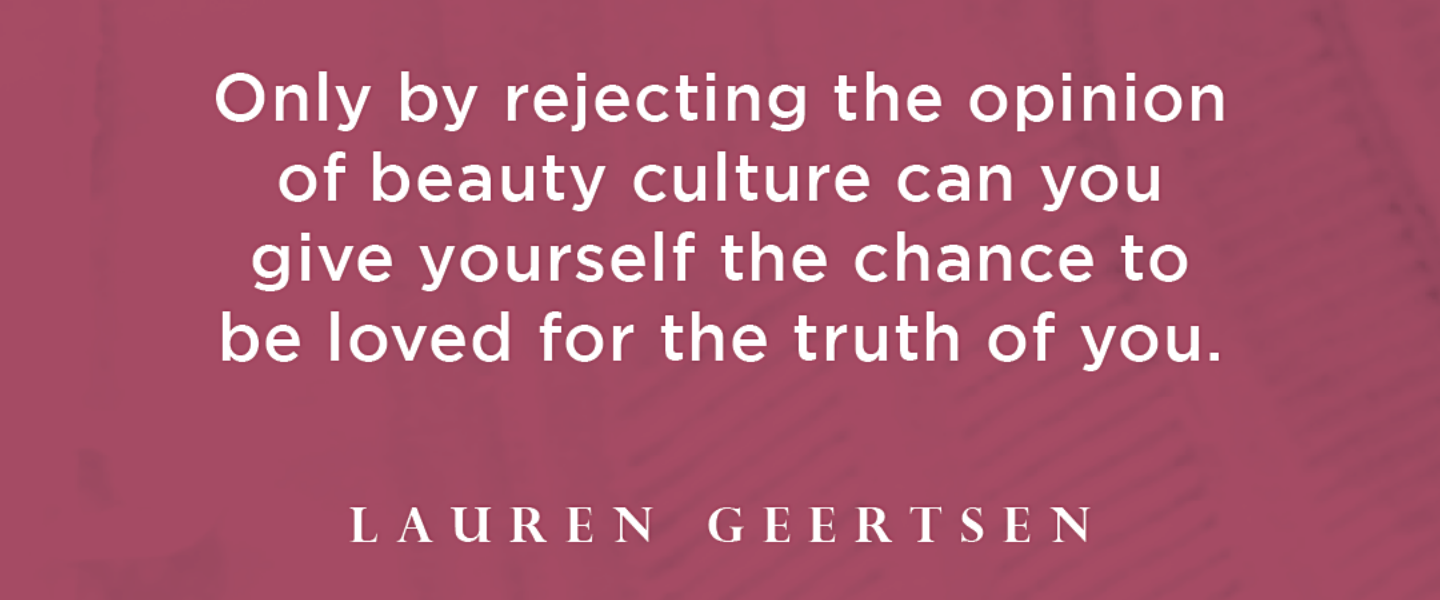
When we feel the need to change our appearance, it’s not because that’s the ultimate goal. We’re using body modification and alteration as a means to a positive emotional experience. But the means are always the end. As long as we use the mindset of body rejection, that’s the only outcome we’ll ever experience—no matter how much our body changes.
When doing this exercise, please note that words like beautiful or desirable do not describe feelings because they are statements of someone else’s perception of you. What we ultimately want is to feel good in our bodies, not to be judged positively by someone. Whenever we want someone’s positive judgment of our bodies, it’s because we think that’s the way we’re going to feel loved, safe, connected, expressive, or happy. Take the shortcut, and just go straight to creating that feeling in your life now.
Feelings are felt experiences in your body. Here are some examples:
Positive feelings: joyful, grateful, exhilarated, excited, aroused, peaceful, affectionate, inspired, hopeful, renewed, fulfilled, enchanted, delighted, calm, amazed, blissful
Negative feelings: hurt, sad, anxious, timid, angry, irritated, afraid, scared, confused, fatigued, tense, numb, helpless, uncomfortable, embarrassed, ashamed, exhausted, depleted, grief, appalled, shocked
Then there are pseudo-feelings—they’re not real feelings, but reflect your judgment of someone’s behavior or situation. Judgments are not feelings, they are mental ideas.
Pseudo-feelings include: abandoned, betrayed, invalidated, manipulated, misunderstood, disrespected, unseen, provoked, threatened, victimized, ignored.
This is an excerpt from The Invisible Corset: Break Free from Beauty Culture and Embrace Your Radiant Self by Lauren Geertsen.
 Lauren Geertsen is a body connection coach who helps women heal their relationship with food and body image. In her previous work as a nutrition consultant, Lauren realized the underlying problem for her clients was distrust of their bodies, which results from wearing the invisible corset. She now helps clients around the world trust their bodies and step into their soul purpose. Her website, empoweredsustenance.com, has supported over 40 million readers with holistic recipes and resources.
Lauren Geertsen is a body connection coach who helps women heal their relationship with food and body image. In her previous work as a nutrition consultant, Lauren realized the underlying problem for her clients was distrust of their bodies, which results from wearing the invisible corset. She now helps clients around the world trust their bodies and step into their soul purpose. Her website, empoweredsustenance.com, has supported over 40 million readers with holistic recipes and resources.
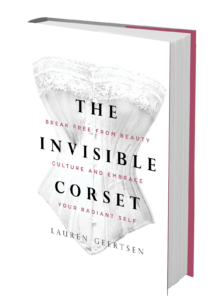 Sounds True | Amazon | Barnes & Noble | Bookshop | Indiebound
Sounds True | Amazon | Barnes & Noble | Bookshop | Indiebound
Tibetan Buddhist Practice for Developing Compassion
Realizing Emptiness and Connection
Take a few minutes to sit peacefully with your eyes closed or looking down. Observe your breath as you breathe in and out.
-
- Allow yourself to breathe naturally, without any modification of the breath.
-
- For a few minutes, simply observe your breath in its most natural state, as it passes through your nostrils.
-
- If you find that you are distracted by your thoughts or sounds, no problem; just go back to observing your breath.
In your mind, see a table.
In English, it is described by the word “table.”
This table is made up of many pieces: a top, legs, glue, nails, and varnish.
The legs and top are made up of wood from a tree. Before the tree was cut down it grew as a result of many variables—sunlight, seeds, rain, earth, and wind, to name just a few.
And before it was a tree, it was a seed from another tree, and another tree before that.
What about the nails or the varnish? Those items can also be traced backward to the people, companies, and components that went into their production.
And the people who created the components also came into being from their parents, and their parents before them.
We now see that everything around us—all phenomena—were caused by something that preceded it and can be traced back to a beginningless time.
Next time, pick another thing, place, or person and go through the same logic. As you go about your day, notice everything around you and apply the same logic.
When you walk around your work or home environment, notice that everything is empty of inherent existence. Everything has a name that refers to a thing that comes together for a time.
Zen teacher Norman Fischer said:
- In the end everything is just designation: things have a kind of reality in their being named and conceptualized, but otherwise they actually aren’t there in the way we think they are. That is, connection is all you find, with no things that are connected.[. . .] It’s the very thoroughness of the connection—without gaps or lumps in it—only the constant nexus wherever you turn—that renders everything void. So everything is empty and connected or empty because connected. Emptiness is connection.
This is an excerpt from The Tibetan Book of the Dead for Beginners: A Guide to Living and Dying by Lama Lhanang Rinpoche and Mordy Levine.
